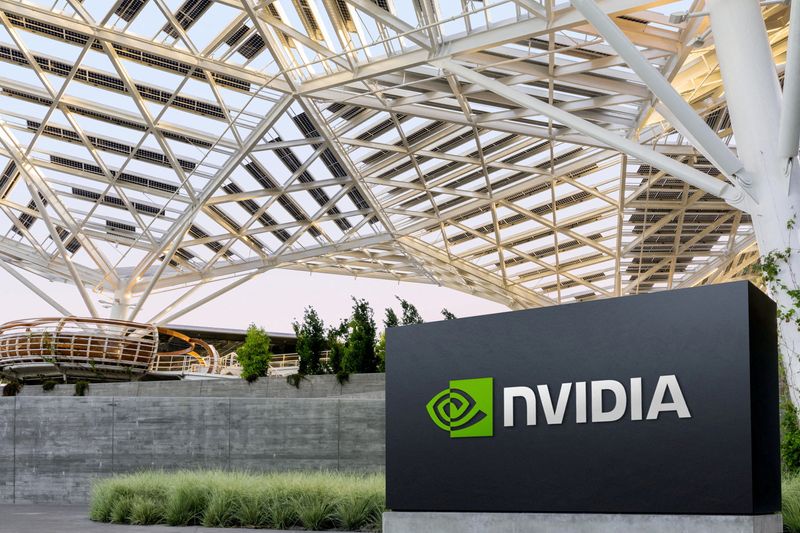Crispr Therapeutics shares tumble after significant earnings miss
PARIS - NVIDIA, the semiconductor giant with a market capitalization of $3.5 trillion and remarkable revenue growth of 86% in the last twelve months, announced Wednesday the expansion of its DGX Cloud Lepton AI platform with additional cloud providers now contributing GPU resources to its global compute marketplace. According to InvestingPro analysis, NVIDIA maintains an excellent financial health score, positioning it strongly for continued market leadership.
Mistral AI, Nebius, Nscale, Firebird, Fluidstack, Hydra Host, Scaleway and Together AI have joined the marketplace, offering NVIDIA Blackwell and other architecture GPUs. AWS and Microsoft Azure will be the first major cloud providers to participate in the platform.
The expansion aims to increase regional access to high-performance computing resources for developers building AI applications. These providers join existing marketplace participants including CoreWeave, Crusoe, Firmus, Foxconn, GMI Cloud, Lambda and Yotta Data Services.
Hugging Face is introducing Training Cluster as a Service, which integrates with DGX Cloud Lepton to connect AI researchers with computing resources. Early users include Mirror Physics, Project Numina and the Telethon Institute of Genetics and Medicine.
"DGX Cloud Lepton is connecting Europe’s developers to a global AI infrastructure," said Jensen Huang, founder and CEO of NVIDIA.
The platform simplifies access to GPU resources within specific regions by unifying cloud AI services onto a single platform, allowing developers to maintain data locality for governance and sovereign AI requirements.
NVIDIA is also partnering with European venture capital firms Accel, Elaia, Partech and Sofinnova Partners to offer marketplace credits to their portfolio companies. Eligible startups can receive up to $100,000 in GPU capacity credits and support from NVIDIA experts.
Early users of the platform include Basecamp Research, EY, Outerbounds, Prima Mente and Reflection, which are using it to accelerate various AI initiatives.
Developers can sign up for early access to the platform, according to the company’s press release statement. While NVIDIA’s stock trades near its 52-week high, InvestingPro analysis suggests the company is currently trading at premium valuations. Investors can access detailed valuation metrics, 20+ additional ProTips, and comprehensive financial analysis through InvestingPro’s detailed research reports, available for over 1,400 US stocks including NVIDIA.
In other recent news, Nvidia has announced several significant collaborations and initiatives aimed at expanding its artificial intelligence capabilities across Europe. Nvidia CEO Jensen Huang revealed that the company’s AI computing capacity in Europe is expected to grow tenfold over the next two years, with new AI technology centers being established in seven European countries. Additionally, Nvidia is partnering with European and Middle Eastern organizations to develop sovereign large language models tailored to local languages and cultures, enhancing enterprise AI workloads’ cost efficiency and accuracy.
In a separate initiative, Nvidia is collaborating with France, Italy, the United Kingdom, and other European nations to build AI infrastructure using Blackwell technology, delivering over 3,000 exaflops of computing power. This partnership aims to support digital sovereignty and economic growth across the continent. Nvidia is also working with L’Oréal to enhance AI capabilities in areas like AI-generated advertisements and product recommendations, utilizing Nvidia’s AI Enterprise platform.
Furthermore, Nvidia and Hewlett Packard Enterprise are teaming up with the Leibniz Supercomputing Centre to construct a new supercomputer, Blue Lion, which will be accessible to scientists by early 2027. This follows the announcement that Jupiter, another supercomputer equipped with Nvidia’s chips, has been declared Europe’s fastest system. These developments underscore Nvidia’s efforts to bolster AI and supercomputing infrastructure in Europe, positioning the region competitively in scientific research and technological innovation.
This article was generated with the support of AI and reviewed by an editor. For more information see our T&C.
